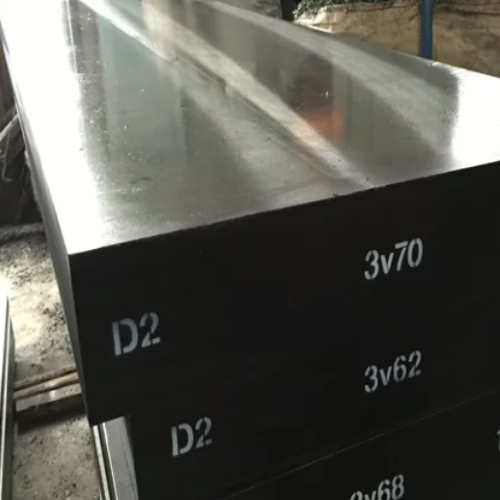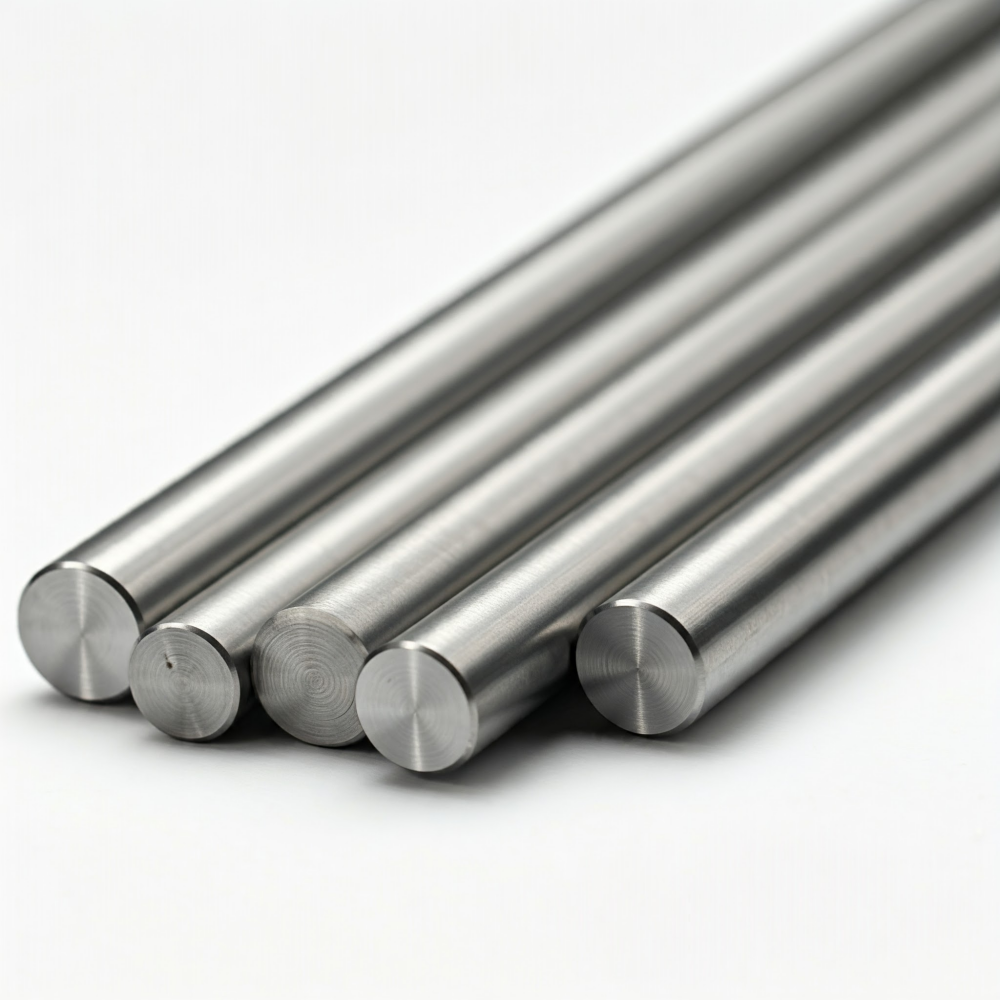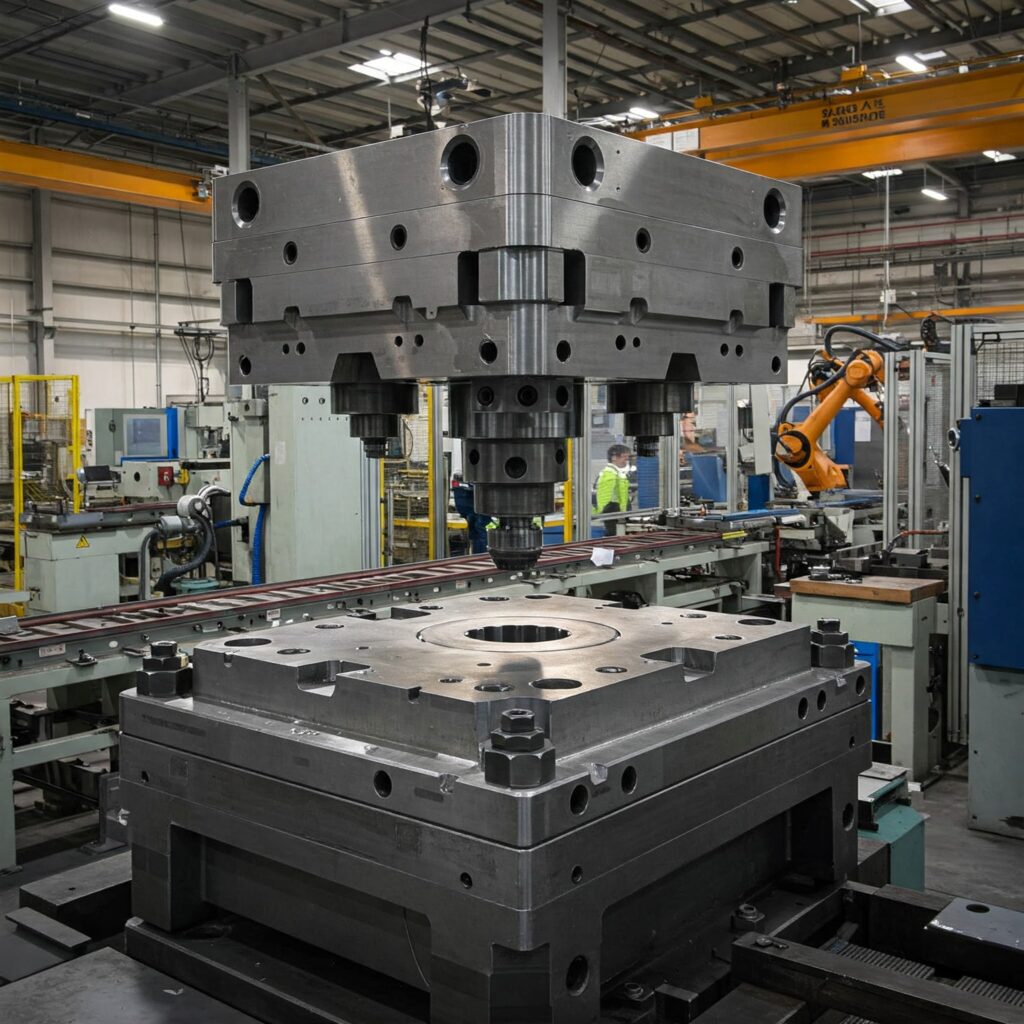Acero para herramientas D2 El acero al carbono D2 y el acero al carbono 1095 son materiales distintos con composiciones, propiedades y aplicaciones diferentes, lo que los hace adecuados para propósitos muy distintos. La principal distinción radica en que el acero D2 es un acero para herramientas de alta aleación, diseñado para ofrecer resistencia al desgaste y estabilidad dimensional. Por otro lado, el acero 1095 es un acero simple con alto contenido de carbono, que se utiliza a menudo por su dureza tras el tratamiento térmico. Presentaremos dos tipos de acero por separado y los compararemos.

Introducción del acero D2
Clasificación y composición
El acero D2 es un acero con alto contenido de carbono y cromo. acero para herramientas en fríoTambién se conoce como acero de temple al aire. Los rangos típicos de composición del acero D2 incluyen aproximadamente 1,40-1,60 de carbono TP3T, 11,00-13,00 de cromo TP3T, 0,70-1,20 de molibdeno TP3T y 0,50-1,10 de vanadio TP3T.
Propiedades
- Resistencia al desgaste: El acero D2 contiene una gran cantidad de carburos tipo M7C3 duros y ricos en cromo, que le proporcionan unas excelentes tener puesto resistencia. Los aceros de la serie D con mayor contenido de carbono, como Acero para herramientas D3 o D6 (similar a D3), tienen un contenido de carburo aún mayor, lo que proporciona una mejor resistencia al desgaste que D2.
- Dureza. Dureza del acero D2 Se puede lograr a 58-64 HRC después del tratamiento térmico.
- Tenacidad. En comparación con otros aceros para herramientas, como Acero para herramientas A2 En comparación con el acero resistente al impacto de la serie S, el acero D2 presenta una menor resistencia al desgaste. Sin embargo, en condiciones reales de uso, la resistencia al desgaste del acero D2 también puede considerarse buena. La alta cantidad de carburos que contribuye a la resistencia al desgaste también puede reducir la tenacidad.
- Estabilidad dimensionalEl acero D2 presenta una excelente estabilidad dimensional durante el tratamiento térmico. La expansión o contracción puede ser de tan solo aproximadamente 0,0005 pulgadas por pulgada (0,0005 mm/mm) cuando se templa al aire a temperaturas de endurecimiento adecuadas.
- Maquinabilidad y rectificabilidadEl acero D2 es difícil de mecanizar y rectificar, principalmente debido a su alto contenido de cromo y su rango de carbono. Su índice de maquinabilidad es de 45, en comparación con el acero al carbono 1%, con un índice de 100.
- SoldabilidadEl acero para herramientas D2 es difícil de soldar o no se puede soldar mediante métodos convencionales debido a su alto contenido de carbono y cantidad significativa de carburos.
- Comportamiento de fractura: Bajo carga de tracción, el acero D2 generalmente no presenta casi ninguna estrangulación antes de la fractura (reducción de área de alrededor de 1.3%) y presenta una superficie de fractura plana. La morfología de la fractura superficial tiende a ser más rugosa, con microporos más grandes, en comparación con el acero O1.
Acero para herramientas D2 Tratamiento térmico
El acero D2 es de temple al aire. La temperatura típica de temple oscila entre 1010 y 1095 °C (1850-2000 °F), seguida de un temple al aire. El revenido se realiza a menudo en dos o incluso tres ciclos, generalmente en el rango de 205 a 540 °C (400-1000 °F), con recomendaciones específicas en torno a 480-515 °C (900-960 °F) para refinar la estructura del grano y mejorar la resistencia al desgaste y la liberación de tensiones. El sobrecalentamiento durante el temple puede aumentar la austenita retenida, lo que podría reducir la dureza deseada. Para más información sobre este tema, consulte Cómo tratar térmicamente correctamente el acero D2.
Aplicaciones
El acero D2 se utiliza ampliamente en aplicaciones de estampación de series largas, punzones y matrices de troquelado y conformado en frío, punzones y matrices de perforación, operaciones de forjado y herramientas de recorte. También se utiliza como inserto en carcasas de acero más resistentes para matrices. Más información sobre Aplicaciones del acero D2 en la fabricación de herramientas.
Introducción de Acero 1095
Clasificación y composición
El acero 1095 es un acero simple con alto contenido de carbono. Su composición típica es de 0,90-1,031 TP3T de carbono y de 0,30-0,501 TP3T de manganeso.
Propiedades
- DurezaEl acero 1095 es capaz de lograr una alta dureza después del temple, por ejemplo, una dureza Rockwell C de 42 después del temple y el trefilado.
- límite elásticoEl límite elástico del acero 1095 varía según factores como el espesor de la barra y la severidad del temple. Las barras más pequeñas y las que se templan más rápidamente desde la temperatura de austenización tienden a tener un límite elástico más alto.
- Ductilidad y tenacidad. La ductilidad está influenciada por la dureza, y generalmente disminuye a medida que aumenta la dureza. El acero 1095 puede lograr una ductilidad mejorada a una dureza determinada en comparación con el acero al carbono simple, como el 1060, cuando está aleado.
- Resistencia al rayadoSu resistencia al rayado es muy baja (<1) en comparación con fundiciones con diversas estructuras de grafito (1,11 a >1,45).
- Resistencia a la corrosión: Los aceros al carbono simples, como el 1095, son generalmente más susceptibles a la corrosión en comparación con los aceros resistentes a la intemperie como el Cor-Ten.
Tratamiento térmico
El acero 1095 puede templarse en aceite, en gas (aire forzado) o en aire en calma (normalizado) desde temperaturas de austenización (p. ej., 900 °C/1650 °F) para alcanzar diferentes niveles de dureza. Por ejemplo, el acero 1095 puede templarse en agua desde 1000 °C (1830 °F) para formar una estructura acicular. La velocidad de enfriamiento del acero 1095 puede aumentarse con una capa muy fina (0,08 mm/0,003 pulg.), pero una capa gruesa (0,13 mm/0,005 pulg.) la retrasa.
Aplicaciones
El acero 1095 es un acero simple con alto contenido de carbono. Es un material candidato para engranajes.
Comparación directa: acero D2 vs. acero 1095
| Característica | Acero para herramientas D2 | Acero al carbono 1095 |
| Tipo/Clase | Acero para herramientas de trabajo en frío con alto contenido de carbono y cromo; endurecimiento al aire. | Acero simple con alto contenido de carbono. |
| Composición | Alto contenido de aleación (1,5% C, 12% Cr, 0,8% Mo, 0,9% V) para la formación de carburo y endurecimiento. | Alto contenido de carbono (0,90-1,03% C) con adiciones de aleación bajas o nulas, típicamente 0,30-0,50% Mn. |
| Mecanismo de fuerza primaria | Se basa en un gran volumen de carburos de aleación dura (M7C3) y en un endurecimiento secundario mediante revenido. | El contenido de carbono permite una alta dureza a través de la transformación martensítica durante el enfriamiento, pero sin un endurecimiento secundario significativo. |
| Resistencia al desgaste | Resistencia a la abrasión de excelente a muy alto nivel. Superior al 1095 gracias a la estabilidad de los carburos de aleación. | Ideal para aplicaciones básicas tras el endurecimiento, pero significativamente inferior a D2. La resistencia al desgaste tiende a aumentar con la cantidad y el tamaño de las partículas de carburo, lo que resulta en una resistencia al rayado muy baja. |
| Dureza | Alto (58-64 HRC). | Alta resistencia tras el temple (p. ej., 42 HRC), pero puede variar. Inferior a D2 en aplicaciones de alto desgaste. |
| Dureza | Moderado a regular. | Puede alcanzar una tenacidad razonable para su clase, pero generalmente inferior a la de los aceros aleados con niveles de dureza comparables. Presenta menor resistencia a la fractura frágil en comparación con los aceros de aleación media para trabajo en caliente. |
| Estabilidad dimensional | Excelente, mínima distorsión. | Dado que el temple en agua se utiliza a menudo para un temple completo, su estabilidad interna es relativamente pobre. |
| Maquinabilidad | Difícil de mecanizar y rectificar. | Difícil o no soldable por métodos convencionales. |
| Soldabilidad | Difícil o no soldable por métodos convencionales. | Se puede soldar, pero requiere una manipulación cuidadosa para evitar posibles grietas provocadas por hidrógeno. |
| Comportamiento de fractura | Temple en agua, aceite o gas desde temperaturas de austenización (p. ej., 900 °C/1650 °F). Revenido para lograr el equilibrio deseado entre dureza y tenacidad. | Los aceros con alto contenido de carbono generalmente muestran una fractura menos dúctil que los aceros con menor contenido de carbono. |
| Tratamiento térmico | Endurecimiento al aire de 1010 a 1095 °C (1850 a 2000 °F), típicamente revenido doble o triple entre 205 y 540 °C (400 a 1000 °F). | Temple en agua, aceite o gas desde temperaturas de austenización (p. ej., 900 °C/1650 °F). Revenido para lograr el equilibrio deseado entre dureza y tenacidad. |
| Coste | Mayor costo | Matrices de larga duración, punzones para troquelado y conformación en frío, herramientas de recorte y punzones de perforación. |
| Aplicaciones típicas | Puede alcanzar una tenacidad razonable para su clase, pero generalmente inferior a la de los aceros aleados con niveles de dureza comparables. Presenta menor resistencia a la fractura frágil en comparación con los aceros de aleación media para trabajo en caliente. | Engranajes, componentes generales de alta dureza o cuando se prefiere un tratamiento térmico simple. |
Resumen
El acero D2 está diseñado para brindar resistencia extrema al desgaste y estabilidad dimensional en aplicaciones de herramientas de alto rendimiento, lo que lo hace adecuado para tiradas de producción largas donde el material de la herramienta contribuye significativamente a los costos generales en matrices grandes. El acero 1095, por otro lado, es un acero con alto contenido de carbono más económico y más simple, elegido para aplicaciones que requieren alta dureza y resistencia en general, sin la necesidad de las propiedades superiores de desgaste del D2 o adiciones de aleaciones complejas.
Obtenga una cotización competitiva para acero para herramientas D2
Con más de 20 años de experiencia en forja, Aobo Steel es su socio de confianza para acero para herramientas D2 de alto rendimiento. Ofrecemos no solo materiales, sino también soluciones. Aproveche nuestro profundo conocimiento del sector y nuestra confiable cadena de suministro para el éxito de su proyecto.
✉Contáctanos rellenando el siguiente formulario.


